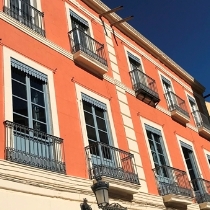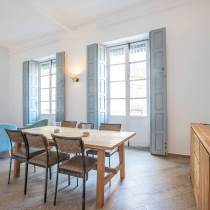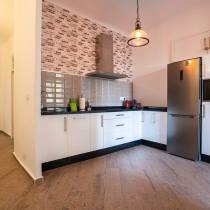Highlights
The center consists of two parts: Casco Antiguo (Old Town), east of Rambla Mendez Nuñez street. West of this street is Centro Traditional, which was added to the center after the first city wall was moved from the Rambla to today’s Avenida Dr Gadea. Ultimately, that wall also had to give way to a traffic artery.
Most topics are provided with two links: To the website of the relevant theme and to the exact location.
MONUMENTS
Ayuntamiento (City Hall) –Plaza de Ayuntamiento 1
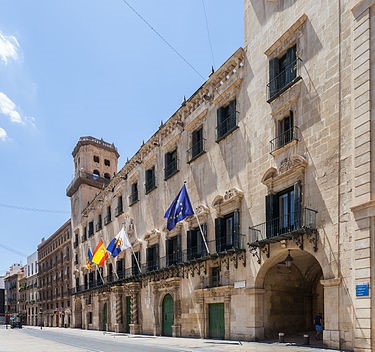
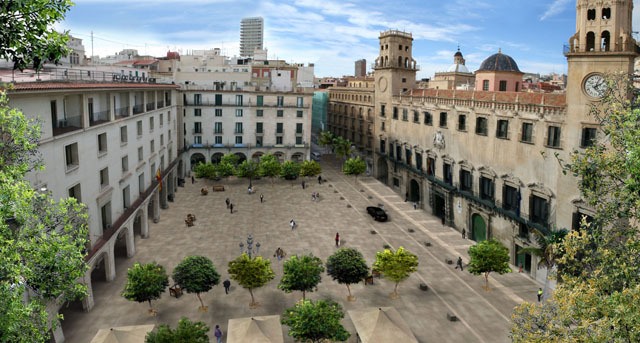
In the 13th century, the first congregational meetings take place in San Nicolas Cathedral. Construction of Ayuntamiento is started, but due to constant lack of money, the building is not completed until 1668 after 127 years of construction. The designed building (larger than the current one) serves as a banquet hall, church, chapel, dungeon, archive, office building, courthouse and meeting room. Devastation followed in 1691 by the three-day French bombardment, but reconstruction started in 1699, which was hampered by the War of the Spanish Succession (1701). -1714 with France and Germany against the rest of Western Europe). Plans are changed into a smaller building. Another attempt at construction follows in 1730, but the death of the leading architect again delays everything until another architect completes the building in 1780. On the stairs hangs a copper sign on the first step that reads ‘Cota Cero’, which is actually 3,407 meters above sea level. This is the official standard for altitude measurement throughout Spain. The standard is calculated from an average of four measurements per day between 1870 and 1872 in the harbour, where a statue now stands (photo). The plateau on which the statue stands is the official point zero.

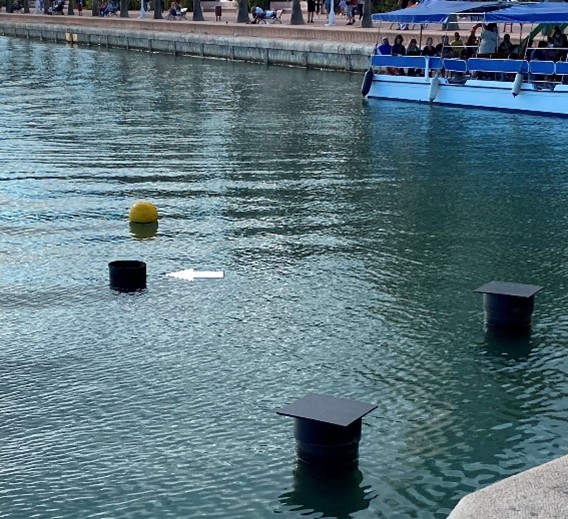
The standard is calculated from an average of four measurements per day between 1870 and 1872 in the harbour, on previous site of the statue stood (photo) that was removed recently. The plateau on which the statue stands (or rather ‘standing’) was the official zero point but has apparently been removed in connection with the construction of a new promenade jetty. A metal tube has been placed there (arrow).
Tossal de Manises (Lucentum), Albufereta
About 3.5 km from the current city center, are the remains of the Carthaginian-Roman ‘Akraleuke’ or ‘Lucentum’ (City of Light). Dating back to the 5th century BC, this historic settlement is 38 meters above sea level and is approximately five football fields in size. In the third century BC the settlement changes with the construction of a city wall with towers, giving the city more and more Roman characteristics.
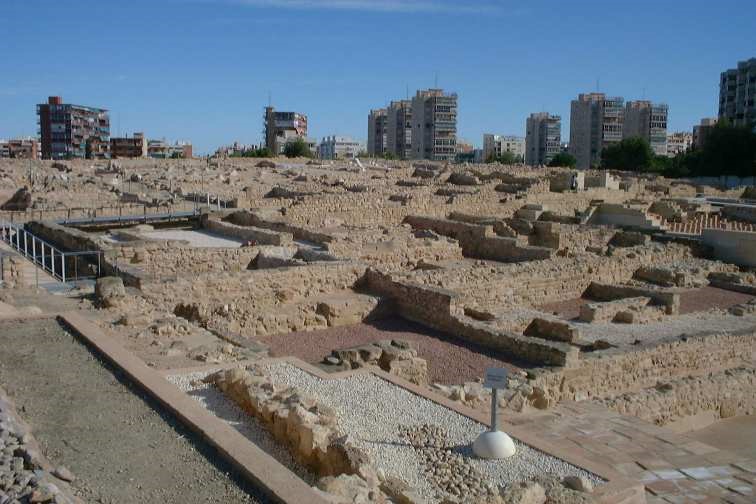
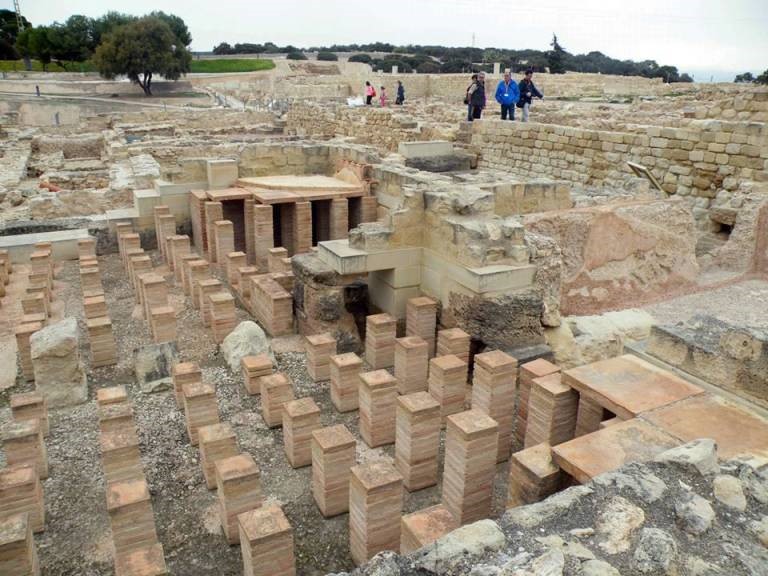
Casa Carbonell, Passeig Esplanada d’España 1 (boulevard)
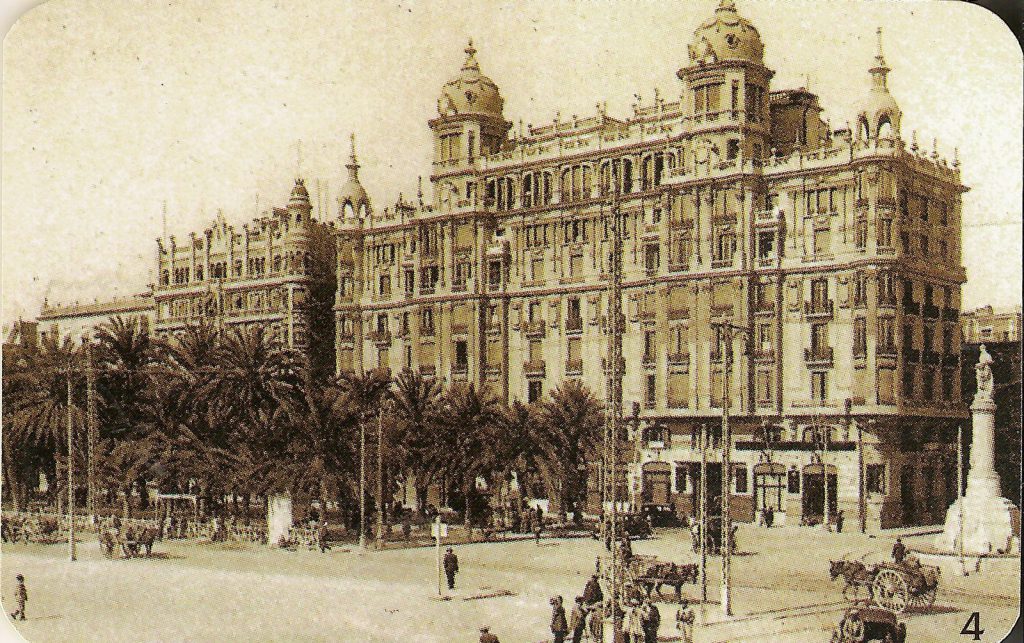 At the beginning of the 20th century, textile giant (Franch army uniforms 1st world war) Enrique Carbonell, on doctor’s advice, regularly goes to Alicante with his sick daughter for the mild and dry climate. During one of the journeys they have to continue on their way due to bad luck and they arrive filthy, with sweaty and torn clothes in the chic Hotel Palas.
At the beginning of the 20th century, textile giant (Franch army uniforms 1st world war) Enrique Carbonell, on doctor’s advice, regularly goes to Alicante with his sick daughter for the mild and dry climate. During one of the journeys they have to continue on their way due to bad luck and they arrive filthy, with sweaty and torn clothes in the chic Hotel Palas.
The staff refuses them because of their soiled appearance. Carbonell is ‘displeased’, whereupon he decides to buy the land next to the hotel. He takes revenge by realizing a building that puts Hotel Palas in the shadow of his own building. Enrique Carbonell dies just before the opening of his showpiece. The property has 365 windows; one for every day of the year.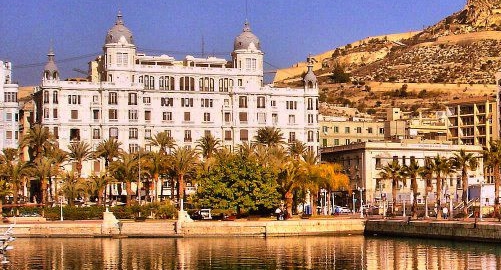
Not by chance as many as the number of palm trees on the boulevard Passeig Explanada de España. The building currently houses shops, offices, restaurants and apartments. Casa Carbonell indeed put the former hotel (bankrupt and now used by the municipality) in the shadows, literally and figuratively. In 1926 a seaplane from Algiers bores into one of the Torentjes. The two occupants are killed.
Basilica de Santa Maria – Plaza Santa Maria 1
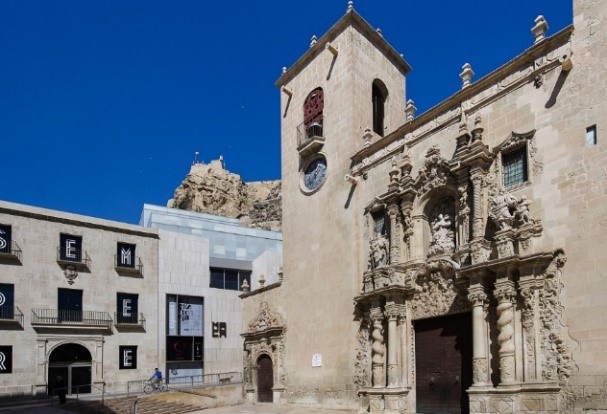
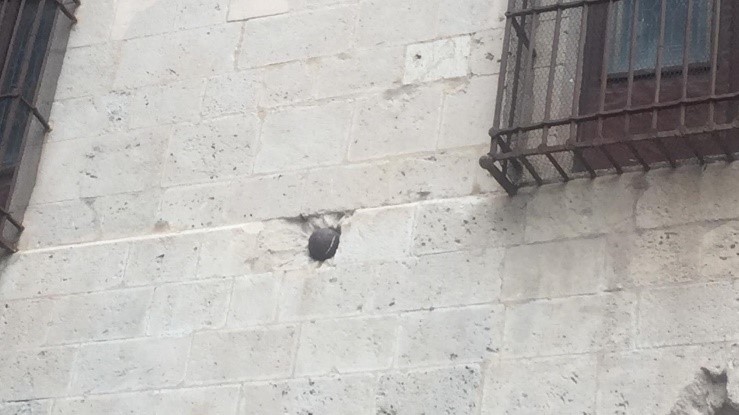
This basilica was built between the 14th and 16th centuries on the foundations (seen through the glass plates) of a Moorish Mosque, like so many churches in Spain. The left tower was added later, because the building was not considered symmetrical enough for the planned visit of the Spanish queen. Left in the 1st photo: Museo MACA Sempere with many modern works by the local modernist Sempere and even more famous artists. The basilica has also been under fire, which can be seen in the photo below. Some bullets are still in the wall. The whole flank is full of holes.
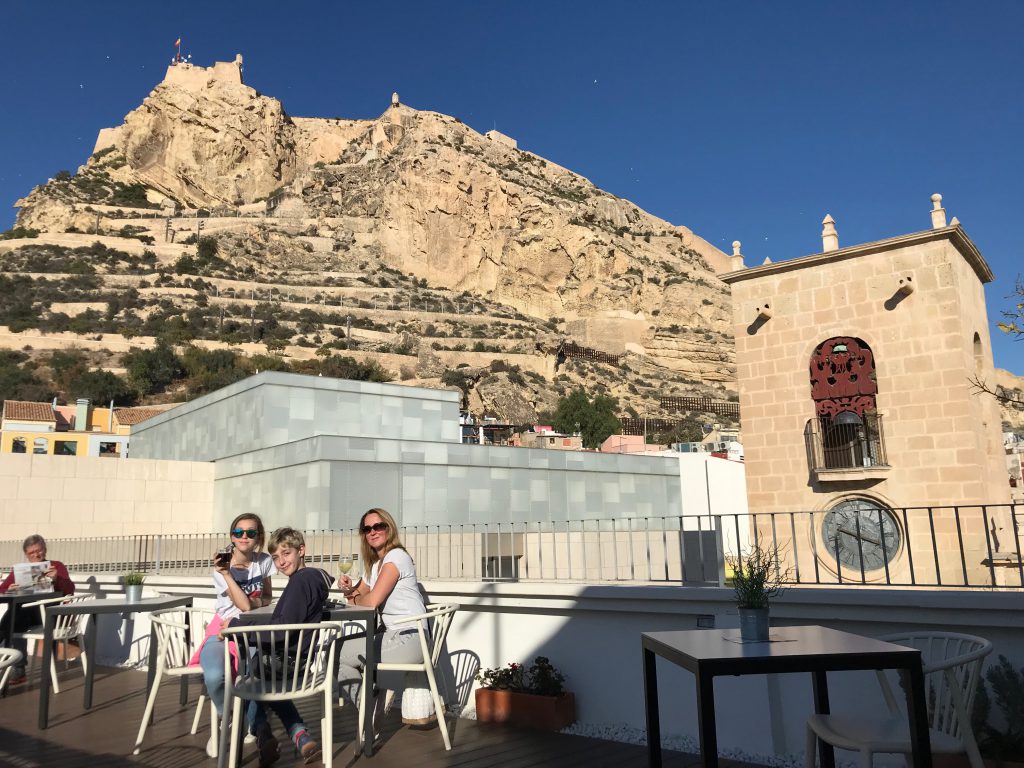
Exactly opposite the church is a freely accessible roof terrace La Milagrosa with beautiful views. There is a sober bar, where the pots with plastic plants do not spoil the fun. Technically, this is an excellent afternoon terrace. More about exploitation in the ‘Restaurants & Bars’ section.
Concatedral de San Nicolás de Bari – Plaza del Abad Penalva 2

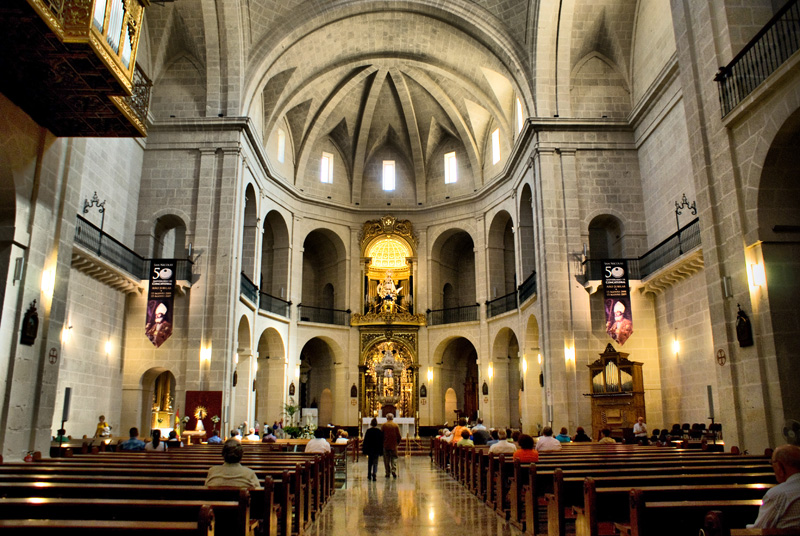
This church, built between 1613 and 1662, became a cathedral in 1959. This church was also built on the foundations of a mosque. The architecture is Valencian Gothic and is considered one of the finest examples of Spanish Baroque. This co-cathedral has six interconnecting side chapels and an ambulatory around the round niche (apse).
Castillo de Santa Barbara on Mount Benacantil
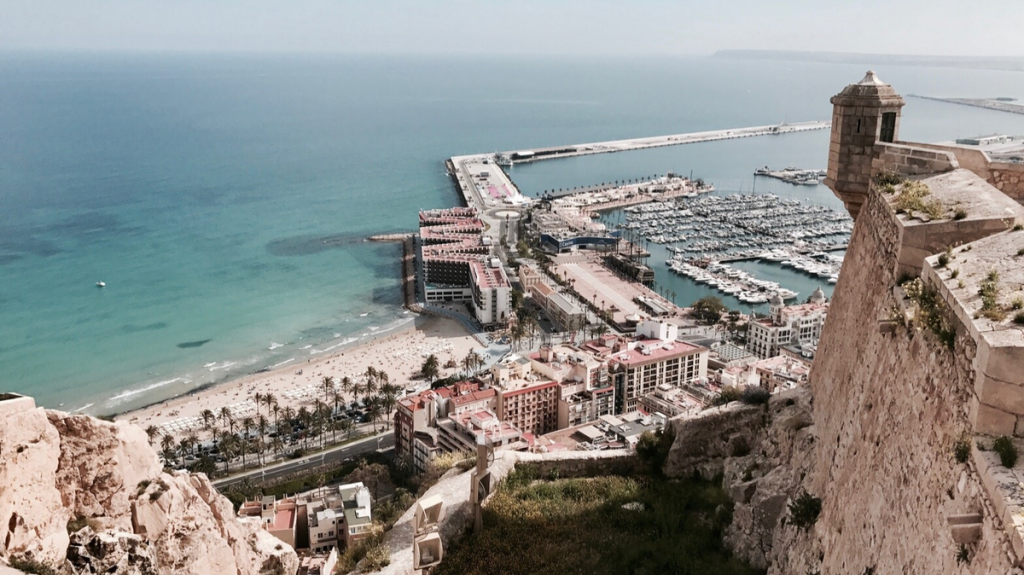
The castle of Santa Barbara is the tourist attraction of Alicante. The first construction is started by the Moors and takes place from 711 on the mountain Benacantil (‘Banu-Qatil’) dominant for the city. The castle was conquered from the Moors after the Reconquista in 1248. The French bomb the castle in 1691 and a few years later it is in the hands of the English for three years during the War of Succession. The last major skirmishes take place during a bombardment in 1873 by the Cantonalistas (revolutionaries).
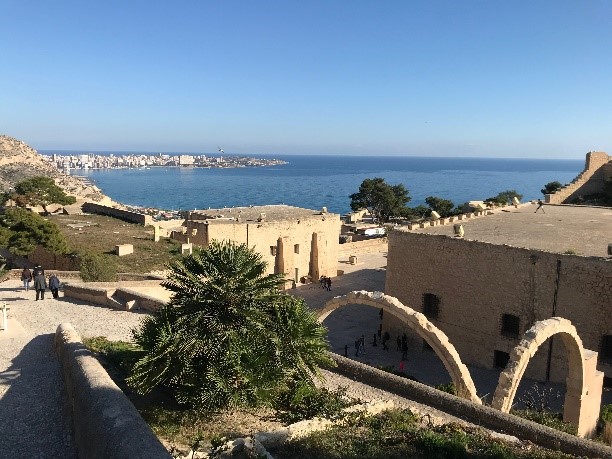
From the 18th century, the castle loses its military importance and is used by Franco as a prison in which he imprisoned his opponents. Santa Barbara has been open to the public since 1963. Although the castle has an elevator – accessible via the tunnel on the boulevard – a walk up is tough, but beautiful.
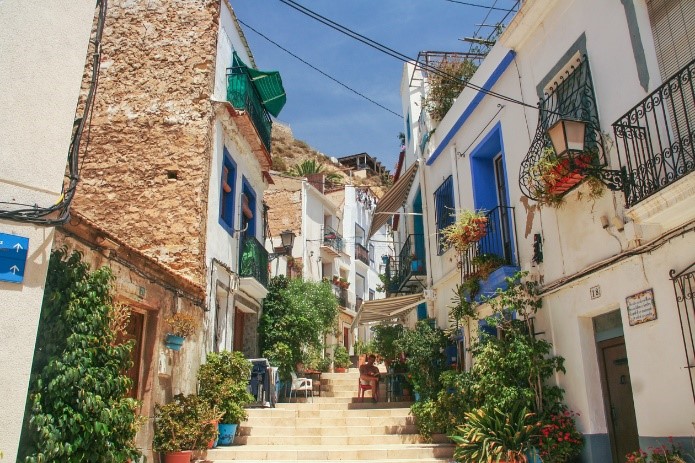
Start the walk up from Plaza del Carmen in the old neighborhood of Santa Cruz, where you take the middle street up. If you see the terrace Rincon de Antonio after 30 meters on the left, then you are in the right place. This is followed by a well-maintained but steep hike up. Allow an average of 20 to 25 minutes for this, although it can also be done within ten minutes with some droplets of sweat. There’s a bar in the castle with terrace that has a beautiful view over the bay. Order a well deserved cool drink!
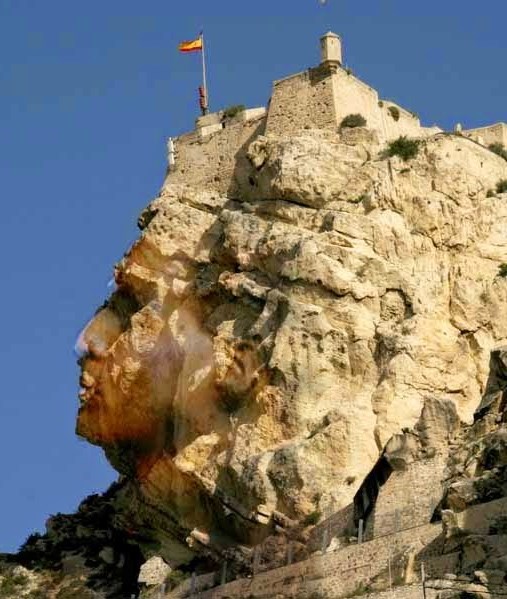 Clearly visible in the rocks is the silhouette of a face. According to tradition, it concerns the father of Cantara, the stunning Moorish daughter of the Caliph. There are many versions of this story, but in each version, Cantara falls madly in love with Ali, who battles his rival Almazor for Cantara’s hand. Vader organizes a competition for both of them with a difficult assignment. Ali chooses not to carry out the assignment, but to win the heart of Cantara with a lot of romance. Almazor thus wins the match and when Ali later sees the wedding scene, he jumps over the castle walls to his death in disbelief. Cantara hears this and jumps after him full of sadness. The suddenly guilty father has himself locked up in one of the turrets and asks Allah to punish him appropriately. He dies from the turret and appears as a silhouette in the rocks. He must undergo his punishment for thousands of years, and erosion will wear out the face and with it his sin. The inhabitants of the city decided to rename their city after Ali and Cantara.
Clearly visible in the rocks is the silhouette of a face. According to tradition, it concerns the father of Cantara, the stunning Moorish daughter of the Caliph. There are many versions of this story, but in each version, Cantara falls madly in love with Ali, who battles his rival Almazor for Cantara’s hand. Vader organizes a competition for both of them with a difficult assignment. Ali chooses not to carry out the assignment, but to win the heart of Cantara with a lot of romance. Almazor thus wins the match and when Ali later sees the wedding scene, he jumps over the castle walls to his death in disbelief. Cantara hears this and jumps after him full of sadness. The suddenly guilty father has himself locked up in one of the turrets and asks Allah to punish him appropriately. He dies from the turret and appears as a silhouette in the rocks. He must undergo his punishment for thousands of years, and erosion will wear out the face and with it his sin. The inhabitants of the city decided to rename their city after Ali and Cantara.
Mercado Central – Av. Alfonso El Sabio 10
Central market of Alicante can safely be called the sadness of Alicante. Located in a neighborhood named after the market (Mercado), at the end of the Rambla. The architecture is eclectic with ornaments from Valencian modernism. The building was designed in 1915 and completed in 1922. The interior space consists of two floors with many stalls of fish, meat, vegetables and fruit. Almost everything looks equally fresh and everyone is equally cheerful. Here and there you can get a snack from a minibar. The market is open from 7:30 AM to 2:30 PM and is well worth a visit.
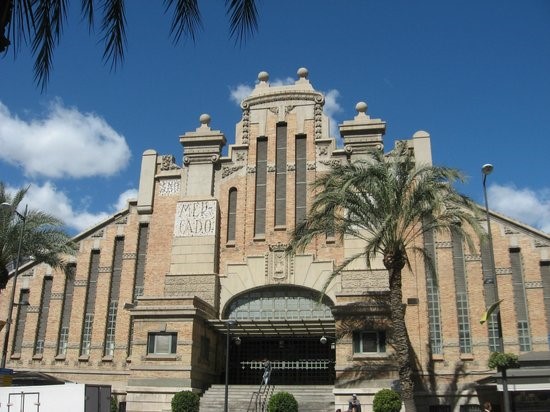
So much for Mercado as you can now visit it. However, Mercado’s past has left deep wounds in Alicante’s community. As described in the chapter ‘History’, Franco had enlisted the help of Mussolini to bomb Alicante and so it happened on May 25, 1938 at 11:17 in the morning.
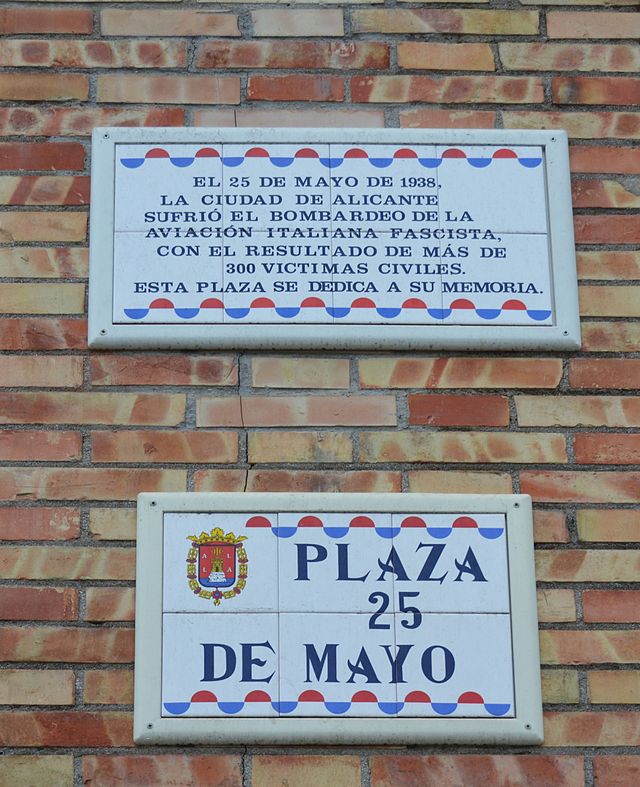
The fascists dropped 90 heavy bombs on the city, many of them on Mercado, where, of course, only civilians were present. The air raid sirens failed and between 275 and 393 civilians were killed, more than 100 of which were bodies that could no longer be identified. More than 1,000 were also injured. The clock in Mercado was never repaired and since then it still stands at 11:17 am, the time of the bombing and can still be found in Mercado (see picture).
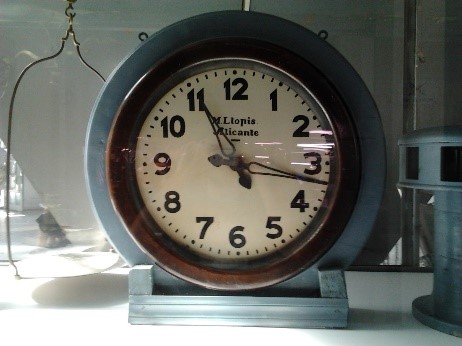
Stadsmuur
Although some parts of the city wall are now preserved, it is clear that this historic wall had to make way for the modernization of Alicante. The wall had several city gates, including the location wher Plaza Portal d’Elche is now. From there to the north and then to the east to where the wall up now starts. On the sea side, the wall ran from Plaza Portal d’Elche to the point where the castle wall winds its way towards the sea. When the city continued to grow in the 19th century, the city wall was moved to the west, where the Avenida Dr. Gadea is now.
Ultimately, this wall also had to make way for the construction of all kinds of buildings and the construction of a traffic artery.
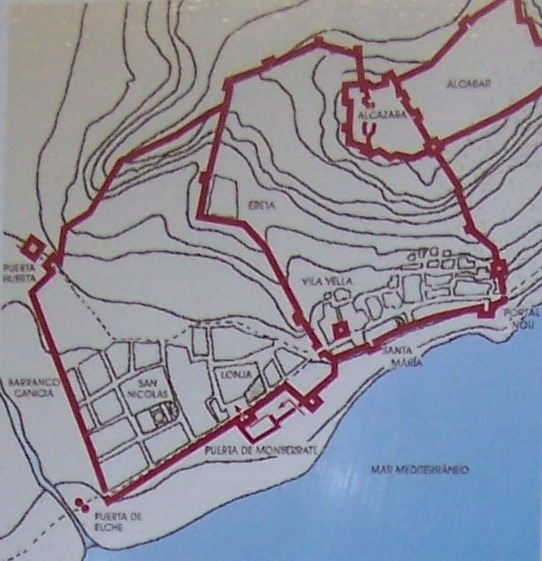
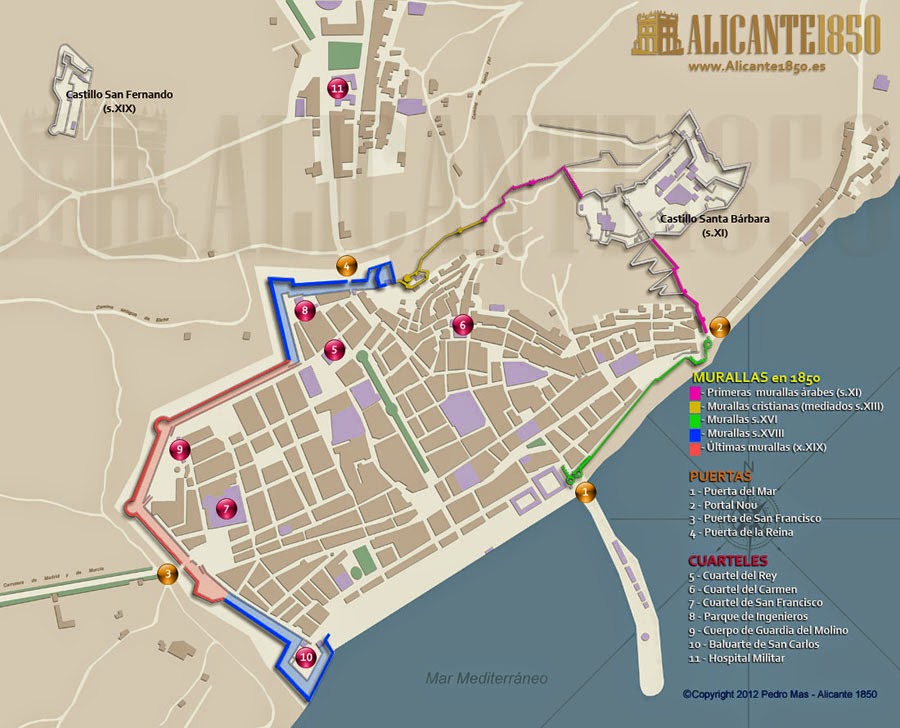
Picture to the left is City Wall 13th Century and to the right you can see Cuty Wall after 1850
STREETS AND SQUARES
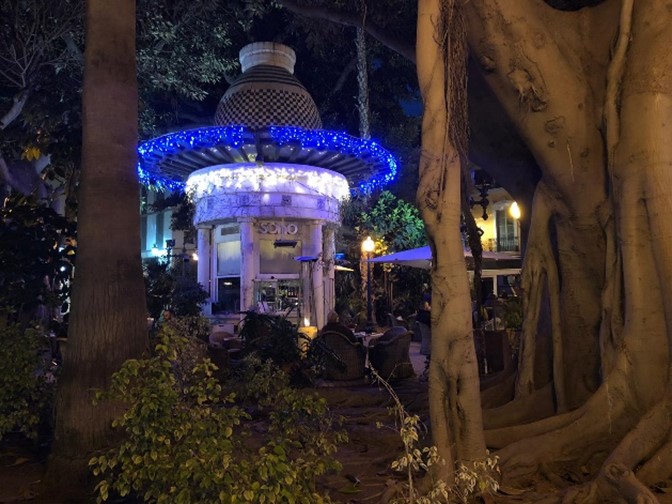
Beautiful square on the Rambla Méndez Núñez, recognizable by the huge trees and the kiosk in the middle, which is centrally located on the attractive terrace. The trees are of the originally South American Ficus Macrophylla family, recognizable by the thick roots that grow from the crown into the ground. The municipality has a lot of work to do to contain the roots, as they pose a direct danger to the foundations of the old buildings around the square. The former city wall of Alicante ran over the Rambla. One of the city gates was located on this square, which has had many names and forms over the centuries. One of the earlier names was ‘Plaza de las Horcas’, or Square of the Gallows, because until 1811 the public executions of those sentenced to death were carried out here. Some time after the abolition of the death penalty, a fountain was built in the center of the square, surrounded by 16 lanterns and four kiosks at the corners of the square. For years, the fountain was the water supply for residents. The water was supplied to surrounding mountains, where the main water reservoirs are still located in reservoirs today. The current kiosk is a replica of one of the former corner kiosks.
Calle San Francisco (or Calle de las Setas)


This street is the symbol for the new start of the city in 2012. In that year Alicante reached its peak of crime: many North African illegals, rampant illegal prostitution, hard drugs and the associated public violence. The municipality intervened by converting the center of this misery, Calle San Francisco, into a cheerful amusement park-like street. The paving stones were painted green/yellow and large colorful mushrooms were placed. For that reason, the street is now popularly called Calle Setas, or Mushroom Street. The plan succeeded and the street is now used jointly by businessmen, tourists and residents. Typical is the large number of tapas bars at the beginning of the street, where the atmosphere is relaxed and cozy.
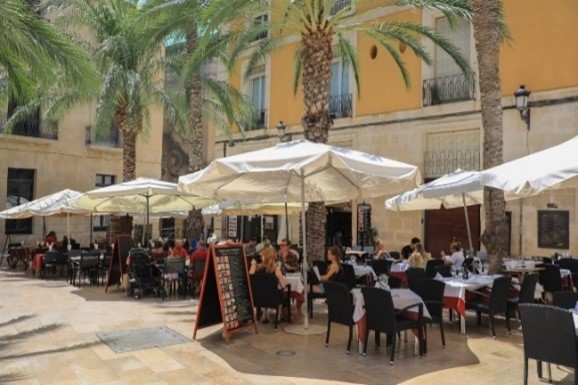
Atmospheric, touristic square with palm trees and attractive terraces. The master staurants on the right of the photo belong to one owner, who seems to be in control. The square is known for the many props, who really appeal to everyone and try to win the competition with sometimes somewhat intrusive jokes and pranks.
It is not without reason that everything is indicated how far it is from Avenida Maisonnave. This wide street is centrally located in the busy shopping area of Alicante, where fashion stores are dominant. As 6th on the list of most expensive shopping streets in Spain, Maisonnave offers an extensive range of shops from El Corte Ingles to Massimo Dutti from small to large and of course all known major chains. Largest and most famous shopping area of the entire Costa Blanca!
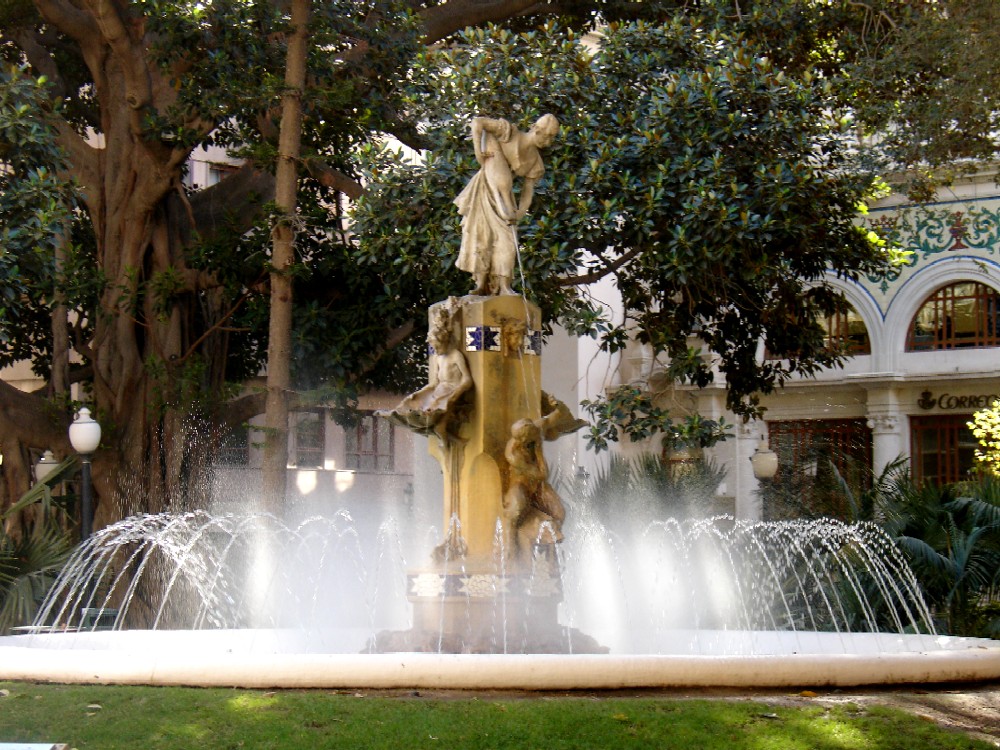
This square is recognizable by the same ‘Elephant Trees’ as on Plaza Porte del Elche. At the end of the 19th century, the drinking water supply was moved from Plaza Portal de Elche to Gabriel Miró. This fountain was also supplied with water from the Alt Vinalopó region. This valley is known for its food grapes which are eaten all over Spain at midnight on New Year’s Eve to wish good fortune (while ladies wear red lingerie under their outerwear for fertility). The beautiful old post office (Oficina Correos) can be seen in the middle of the back of both photos.

The statue in the fountain in Plaza de Gabriel Miró is called ‘Moza del Cántaro’, or ‘Girl with the pitcher’. This statue is inspired by the beautiful Susanna, the neighbor of the local sculptor. This Vicente Bañuls was so enchanted by the girl with brown hair and blue eyes that he insisted on her father to be allowed to make a statue of her. However, Dad thought Susanna was too young and it was socially unacceptable. This steadfastness disappeared quite fast when a sum of money was offered, after which Susanna was involved for a year in the creation of ‘La Aguadora’, as we know it today.
Marina – Puerto deportivo Alicante
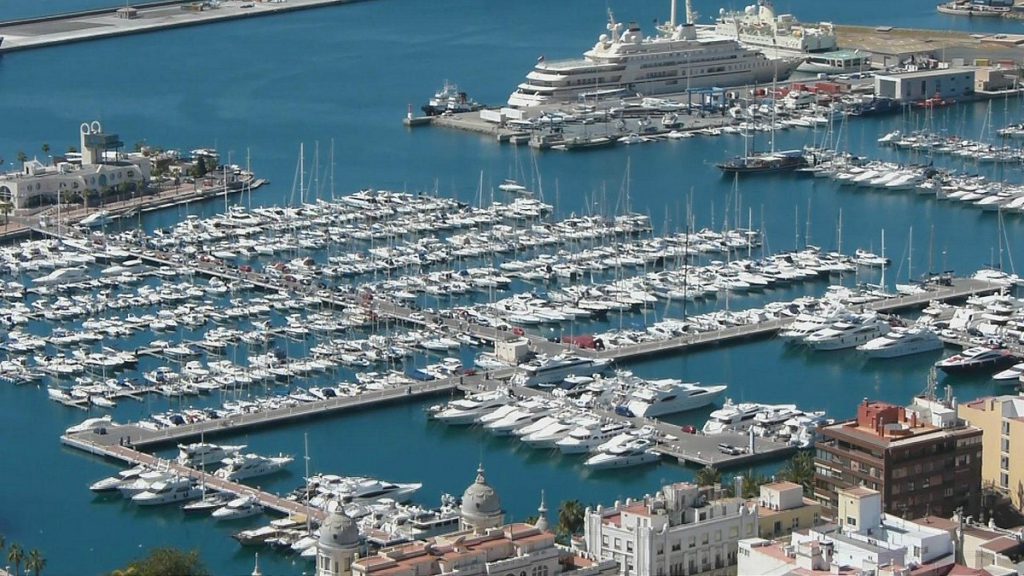
Next to the industrial port is the marina of Alicante.
As can be seen in the photo, quite a few boats have their permanent berth there. At the height of the aforementioned ‘Casa Carbonell’ begins the wide promenade (with underlying parking basement) on which all kinds of facilities are located. Via lounge bar Soho Mar you walk to a variety of restaurants, a casino, bars, the Ocean Race Museum (free) and of course shops for the boat owners. Moreover, there is Restaurant, Club, Swimming Pool Marmarela, about which more in the chapter Catering.
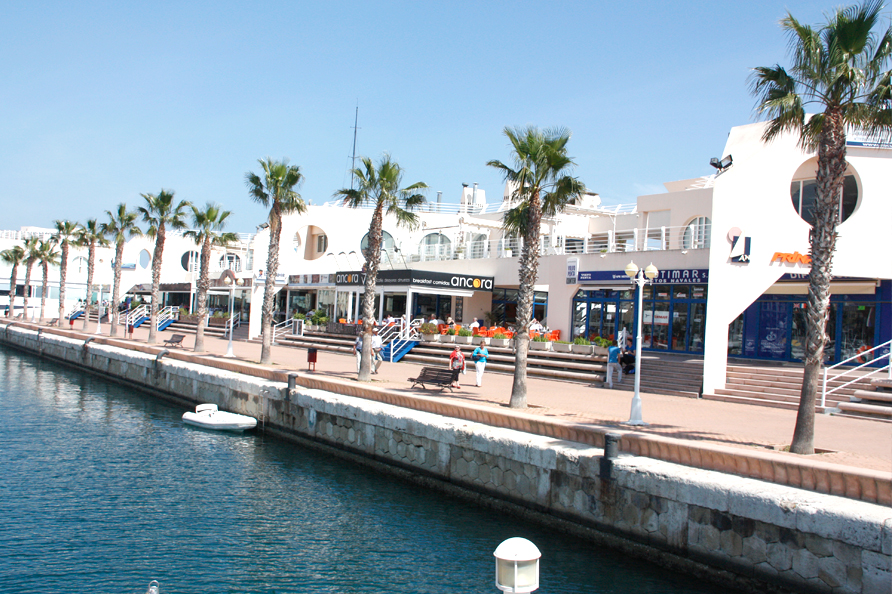
Various restaurants and bars in the harbor
Read more at Apartment, History of Alicante, Restaurants & Bars, Tips & Tours or send an email to
info@casaluzapartamento.com

 NL
NL EN
EN ES
ES